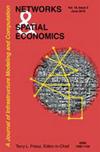Convergence of Income Inequality in Russia’s Regions
IF 1.5
3区 工程技术
Q3 OPERATIONS RESEARCH & MANAGEMENT SCIENCE
引用次数: 0
Abstract
In this paper we test convergence of income inequality in Russia’s regions for the period 1995–2020. To do this, conditional and unconditional beta convergence models for the regional Gini index are evaluated on cross-sectional and panel data using time and spatial effects. Estimates of the models show that both conditional and unconditional convergence of income inequality takes place in Russia’s regions. It is shown that the rate of convergence varies significantly within the considered period: the levels of income inequality in the regions converged most strongly at the beginning of the period with a gradual slowdown in the rate of convergence in subsequent periods. This result may be related to the recovery growth and redistribution policy in the 2000s, as well as the consequences of the 2014 crisis. The use of the same initial characteristics, such as GRP per capita, level of education and population, accelerates convergence. Spatial effects are statistically significant for models of unconditional, but not conditional convergence, but do not affect the estimates obtained. When considering a panel data structure with the inclusion of fixed time effects, convergence estimates increase for both unconditional and conditional convergence俄罗斯地区收入不平等的趋同
在本文中,我们检验了1995-2020年期间俄罗斯地区收入不平等的收敛性。为此,利用时间和空间效应对截面数据和面板数据评估了区域基尼指数的条件和无条件贝塔收敛模型。对模型的估计表明,收入不平等的条件收敛和无条件收敛都发生在俄罗斯的地区。研究表明,在所考虑的时期内,趋同率变化很大:各地区的收入不平等水平在该时期开始时趋同最强烈,随后各时期的趋同率逐渐放缓。这一结果可能与2000年代的复苏增长和再分配政策以及2014年危机的后果有关。使用相同的初始特征,如人均国内生产总值、教育水平和人口,加速了趋同。空间效应在统计上是显著的,而不是条件收敛的模型,但不影响所得到的估计。当考虑包含固定时间效应的面板数据结构时,无条件和条件收敛的收敛估计都会增加
本文章由计算机程序翻译,如有差异,请以英文原文为准。
求助全文
约1分钟内获得全文
求助全文
来源期刊

Networks & Spatial Economics
社会科学-运筹学与管理科学
CiteScore
4.00
自引率
4.20%
发文量
26
审稿时长
>12 weeks
期刊介绍:
Networks and Spatial Economics (NETS) is devoted to the mathematical and numerical study of economic activities facilitated by human infrastructure, broadly defined to include technologies pertinent to information, telecommunications, the Internet, transportation, energy storage and transmission, and water resources. Because the spatial organization of infrastructure most generally takes the form of networks, the journal encourages submissions that employ a network perspective. However, non-network continuum models are also recognized as an important tradition that has provided great insight into spatial economic phenomena; consequently, the journal welcomes with equal enthusiasm submissions based on continuum models.
The journal welcomes the full spectrum of high quality work in networks and spatial economics including theoretical studies, case studies and algorithmic investigations, as well as manuscripts that combine these aspects. Although not devoted exclusively to theoretical studies, the journal is "theory-friendly". That is, well thought out theoretical analyses of important network and spatial economic problems will be considered without bias even if they do not include case studies or numerical examples.
 求助内容:
求助内容: 应助结果提醒方式:
应助结果提醒方式:


